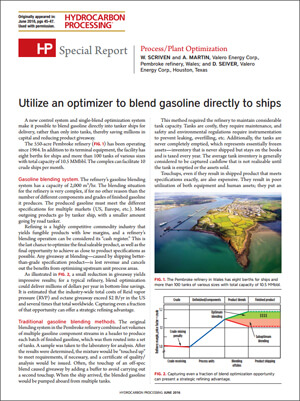For refineries, blending operations can be challenging due to unscheduled downtime, off-spec production requiring reblending operations and quality giveaways by exceeding specifications.
I caught up with Emerson’s Marcelo Carugo who noted that poor recipe management and control throughout the blending process increases variability in product quality, which not only leads to off-spec product that requires reblending and derails the production schedule.
 This condition may also lead to quality giveaways, causing cost overrun in blending operations or suboptimum blends which use more expensive blend stocks.
This condition may also lead to quality giveaways, causing cost overrun in blending operations or suboptimum blends which use more expensive blend stocks.
A Hydrocarbon Processing special report, Utilize an optimizer to blend gasoline directly to ships, describes a U.K. refiner’s control system and single-blend optimization system to blend gasoline directly to tanker ships.
This approach beyond the traditional approach of blending into storage tanks saved millions in capital and reduced product giveaway. The article’s authors from the refining company define giveaway and its impact:
Any giveaway at blending—caused by shipping better-than-grade specification product—is lost revenue and cancels out the benefits from optimizing upstream process unit areas.
The traditional blend method:
…combined set volumes of multiple gasoline component streams in a header to produce each batch of finished gasoline, which was then routed into a set of tanks. A sample was taken to the laboratory for analysis. After the results were determined, the mixture would be “touched up” to meet requirements, if necessary, and a certificate of quality/analysis would be issued.
This blended gasoline would be pumped from multiple tanks to the ship for export. This approach required considerable capital investments in tanks, costly maintenance to store safely and environmentally soundly, and financially stayed on the books as inventory.
A study was undertaken to improve the blending process and to replace the tank storage process with directly inline blending. It:
…had the potential to save millions of dollars each year by reducing the number of tanks needed in gasoline service, as well as satisfy the key performance indicators of lower average blend giveaway and the minimization of touchup blends.
For the solution:
Each batch of finished gasoline is made by simultaneously blending up to 21 different component streams in a header—typically 10 or fewer streams at a time, with mid-blend pump and tank changes. Each component has a flowmeter, a proportional integral derivative (PID) controller and a target ratio set by the control system. A set of online analyzers provide feedback for optimization and certification using state-of-the-art redundant sample compositors. The system can achieve up to 20 quality limits simultaneously, although the number is usually closer to five. The output of the blending system (finished gasoline) can go into tanks or directly onto a ship.
Read the article to see the architecture, approach to gaining operator acceptance, and project challenges encountered. Results are monitored through key performance indicators (KPIs) with monthly tracking:
…of the optimizer savings and performance. To date, the results have shown excellent performance, and the new system provides more flexibility for product planning and scheduling. The site has been able to maximize the cost of finished product by blending the least costly components required to make on-spec gasoline.
You can connect and interact with other refining experts in the Refining group in the Emerson Exchange 365 community.





